直接引语和间接引语总结归纳复习过程
- 格式:doc
- 大小:40.00 KB
- 文档页数:6
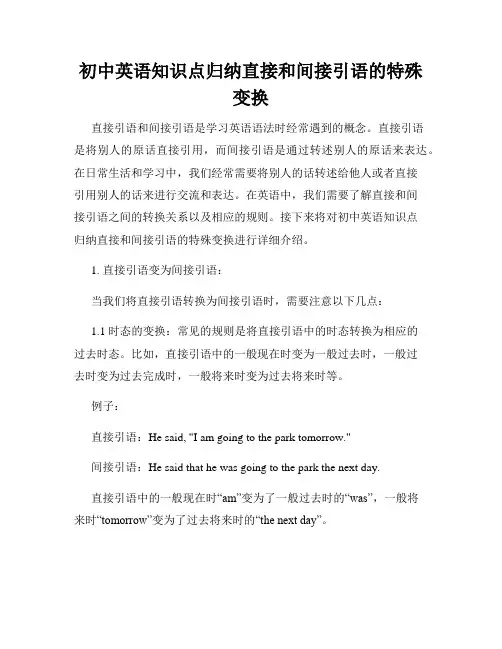
初中英语知识点归纳直接和间接引语的特殊变换直接引语和间接引语是学习英语语法时经常遇到的概念。
直接引语是将别人的原话直接引用,而间接引语是通过转述别人的原话来表达。
在日常生活和学习中,我们经常需要将别人的话转述给他人或者直接引用别人的话来进行交流和表达。
在英语中,我们需要了解直接和间接引语之间的转换关系以及相应的规则。
接下来将对初中英语知识点归纳直接和间接引语的特殊变换进行详细介绍。
1. 直接引语变为间接引语:当我们将直接引语转换为间接引语时,需要注意以下几点:1.1 时态的变换:常见的规则是将直接引语中的时态转换为相应的过去时态。
比如,直接引语中的一般现在时变为一般过去时,一般过去时变为过去完成时,一般将来时变为过去将来时等。
例子:直接引语:He said, "I am going to the park tomorrow."间接引语:He said that he was going to the park the next day.直接引语中的一般现在时“am”变为了一般过去时的“was”,一般将来时“tomorrow”变为了过去将来时的“the next day”。
1.2 人称的变换:当直接引语中含有一、二人称时,需要根据引用者的身份和角色进行相应的人称变换。
一般来说,第一人称变为第三人称,第二人称变为第二人称或者第三人称。
例子:直接引语:She said, "I can swim."间接引语:She said that she could swim.直接引语中的第一人称“I”变为了第三人称的“she”。
1.3 地点和时间的变换:当直接引语中涉及具体的时间和地点时,需要相应地进行变换。
一般来说,指示时间和地点则根据转述时发生的情况来确定。
例子:直接引语:He said, "I will meet you here at 5 o'clock."间接引语:He said that he would meet me there at 5 o'clock.直接引语中的地点“here”变为了间接引语中的地点“there”。
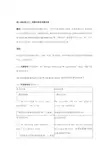
初二语法复习之一直接引语和间接引语概念:直接引语和间接引语都是宾语。
一字不改地引述别人的话,叫做直接引语;用说话人自己的话转述别人的话,叫做间接引语。
两种引语皆须由动词引述,这种动词叫做引述动词,如say,tell,ask,declare,remark,reply,think,write等。
直接引语一般皆置于引号之内,第一个词的首字母须大写;间接引语通常在句中以宾语从句的形式出现。
变法:1.直接引语变为间接引语时,人称、时态、指示代词、时间和地点状语及某些动词要用相应变化。
其变法如下:(1)、人称变化与汉语相同。
如:She said, “I went to see Mr. Liu yesterday.” 她说:“我昨天去看过刘老师了。
”She said that she had gone to see Mr. Liu the day before. 她说那天她去看过刘老师了。
(2)、时态的变化列表如下:但是,要注意下面的情况:直接引语说的是科学真理、格言时,无论主句用何时态,间接引语仍用一般时。
如:The teacher said, “The sun rises in the east and sets in the west.”老师说:“太阳在东方升起,在西边落下。
”The teacher said that the sun rises in the east and sets in the west.(3) 指示代词、时间和地点状语及某些动词的变化列表如下:2.直接引语可以变为间接引语,直接引语主要四种类型变化。
直接引语变间接引语练习题1. He asked ________ for the computer.A. did I pay how muchB. I paid how muchC. how much did I payD. how much I paid2. “Have you seen the film?” he asked me. →He asked me _______.A. had I seen the filmB. have I seen the filmC. if I have seen the filmD. whether I had seen the film3. “Please close the window,” he said to me.→He ______ me _____ the window.A. said to; to closeB. told to; closingC. asked ; to closeD. said to; please close4. “I am a teacher,” Jack said. →He said _________.A. that I am a teacherB. I was a teacherC. that he is a teacherD. he was a teacher5. He said, “Mother, the boy is very naughty.” →He _____- very naughty.A. said his mother that the boy wasB. said to his mother that the boy isC. told his mother that the boy wasD. spoke to his mother that the boy was6. “You’ve already got well, haven’t you?” she asked.→She asked ________.A. if I have already got well, hadn’t youB. whether I had already got wellC. have I already got wellD. had I already got well.7. He asked , “ Are you a Party member or a League member?”→He asked me _________.A. am I a Party member or a League memberB. was I a Party member or a League memberC. if I was a Party member or a League memberD. whether was I a Party member or a League member.8. He asked, “How are you getting along?” →He asked _______.A. how am I getting alongB. how are you getting alongC. how I was getting alongD. how was I getting along9. He asked me ________ with me.A. what the matter isB. what the mater wasC. what’s the matterD. what was the matter10. He said, “Don’t do that again.” He _____ me _______ that again.A. said to me; not to doB. said to me; don’t doC. told me; don’t doD. told me; not to do答案与简析:1. D 宾语从句要用陈述句语序。
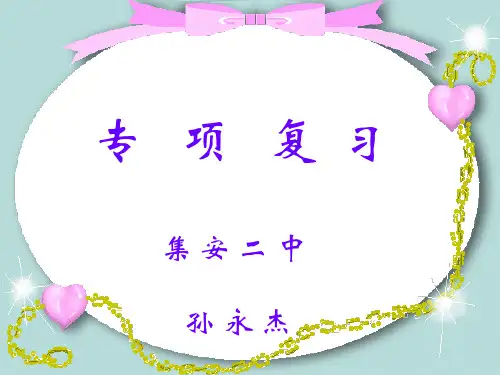
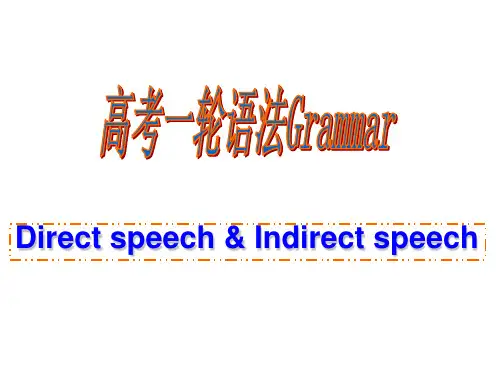
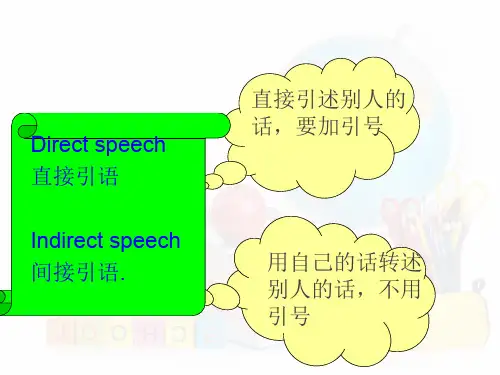
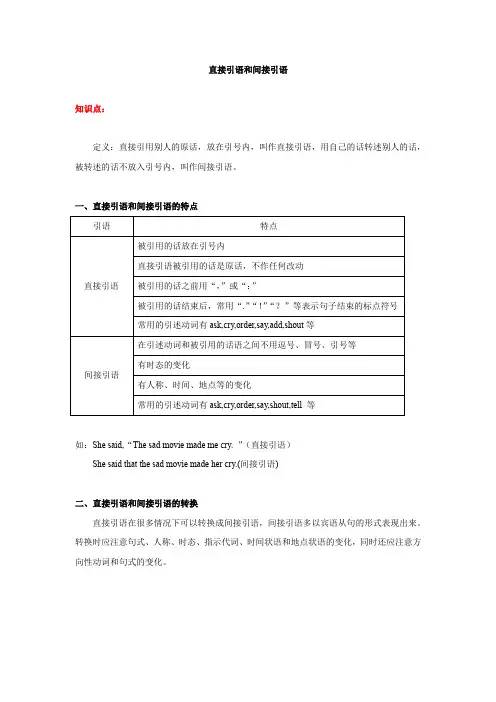
直接引语和间接引语知识点:定义:直接引用别人的原话,放在引号内,叫作直接引语,用自己的话转述别人的话,被转述的话不放入引号内,叫作间接引语。
一、直接引语和间接引语的特点引语特点直接引语被引用的话放在引号内直接引语被引用的话是原话,不作任何改动被引用的话之前用“,”或“:”被引用的话结束后,常用“.”“!”“?”等表示句子结束的标点符号常用的引述动词有ask,cry,order,say,add,shout等间接引语在引述动词和被引用的话语之间不用逗号、冒号、引号等有时态的变化有人称、时间、地点等的变化常用的引述动词有ask,cry,order,say,shout,tell 等如:She said,“The sad movie made me cry. ”(直接引语)She said that the sad movie made her cry.(间接引语)二、直接引语和间接引语的转换直接引语在很多情况下可以转换成间接引语,间接引语多以宾语从句的形式表现出来。
转换时应注意句式、人称、时态、指示代词、时间状语和地点状语的变化,同时还应注意方向性动词和句式的变化。
1.人称的变化直接引语在变为间接引语时,人称代词的变化通常遵循“一随主、二随宾,第三人称不更新”的原则。
“一随主”原则:直接引语中的第一人称代词(I,we)变为间接引语时,须与引述动词的主语在人称和数上保持一致。
直接引语:“It was exactly what I needed,"he said.间接引语:He said that it was exactly what he needed.他说这正是他所需要的。
(He为引述动词的主语)“二随宾”原则:直接引语中的第二人称代词(you)变为间接引语时,须与引述动词的宾语在人称和数上保持一致。
直接引语:My teacher told me," You should be on time next time."间接引语:My teacher told me that I should be on time next time.我的老师告诉我下次应该准时。
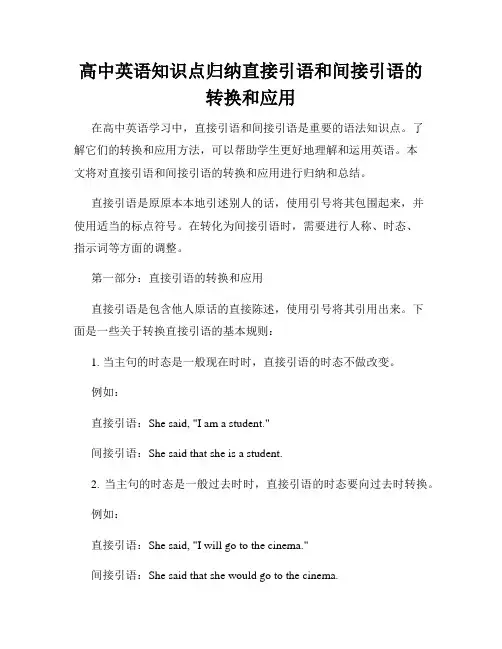
高中英语知识点归纳直接引语和间接引语的转换和应用在高中英语学习中,直接引语和间接引语是重要的语法知识点。
了解它们的转换和应用方法,可以帮助学生更好地理解和运用英语。
本文将对直接引语和间接引语的转换和应用进行归纳和总结。
直接引语是原原本本地引述别人的话,使用引号将其包围起来,并使用适当的标点符号。
在转化为间接引语时,需要进行人称、时态、指示词等方面的调整。
第一部分:直接引语的转换和应用直接引语是包含他人原话的直接陈述,使用引号将其引用出来。
下面是一些关于转换直接引语的基本规则:1. 当主句的时态是一般现在时时,直接引语的时态不做改变。
例如:直接引语:She said, "I am a student."间接引语:She said that she is a student.2. 当主句的时态是一般过去时时,直接引语的时态要向过去时转换。
例如:直接引语:She said, "I will go to the cinema."间接引语:She said that she would go to the cinema.3. 当直接引语是被引述者的陈述句时,可以使用that来引导间接引语。
例如:直接引语:He said, "I am happy."间接引语:He said that he was happy.第二部分:间接引语的转换和应用间接引语是将直接引语转换为自己的话,不使用引号,而是通过动词引导和适当的调整来传达别人的话。
以下是一些关于应用间接引语的基本规则:1. 当直接引语中有一些特定的指示词(如now、here、this、these),在转换成间接引语时要进行相应的改变。
例如:直接引语:She said, "I am going now."间接引语:She said that she was going then.2. 当引述者自己有一些表示过去的指示词时,要根据语境进行适当调整。
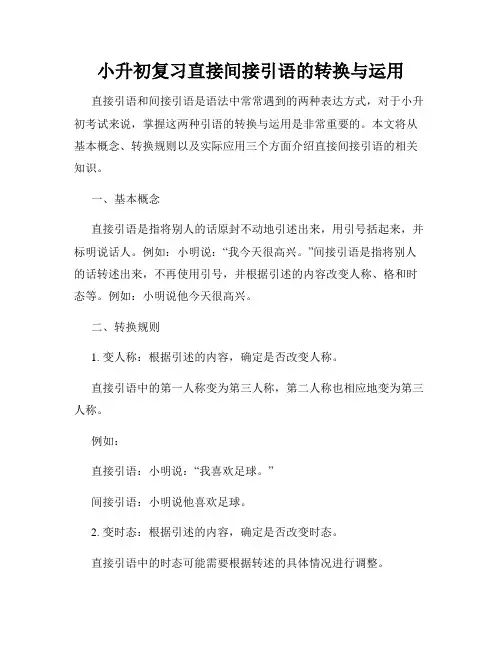
小升初复习直接间接引语的转换与运用直接引语和间接引语是语法中常常遇到的两种表达方式,对于小升初考试来说,掌握这两种引语的转换与运用是非常重要的。
本文将从基本概念、转换规则以及实际应用三个方面介绍直接间接引语的相关知识。
一、基本概念直接引语是指将别人的话原封不动地引述出来,用引号括起来,并标明说话人。
例如:小明说:“我今天很高兴。
”间接引语是指将别人的话转述出来,不再使用引号,并根据引述的内容改变人称、格和时态等。
例如:小明说他今天很高兴。
二、转换规则1. 变人称:根据引述的内容,确定是否改变人称。
直接引语中的第一人称变为第三人称,第二人称也相应地变为第三人称。
例如:直接引语:小明说:“我喜欢足球。
”间接引语:小明说他喜欢足球。
2. 变时态:根据引述的内容,确定是否改变时态。
直接引语中的时态可能需要根据转述的具体情况进行调整。
例如:直接引语:小明说:“我要去北京。
”间接引语:小明说他要去北京。
3. 变语态:根据引述的内容,确定是否需要改变语态。
如果直接引语是主动语态,间接引语可能需要改变为被动语态,反之亦然。
例如:直接引语:老师说:“小明写了一篇好文章。
”间接引语:老师说小明写了一篇好文章。
三、实际应用1. 陈述句的转换陈述句的直接引语转换为间接引语时,可以根据转换规则进行人称、时态和语态的相应变化。
例如:直接引语:他说:“我昨天去了图书馆。
”间接引语:他说他昨天去了图书馆。
2. 疑问句的转换疑问句的直接引语转换为间接引语时,需要将疑问句变为陈述句,并根据转换规则进行相应变化。
例如:直接引语:小明问:“你喜欢吃苹果吗?”间接引语:小明问他是否喜欢吃苹果。
3. 祈使句的转换祈使句的直接引语转换为间接引语时,需要将祈使句变为陈述句,并根据转换规则进行相应变化。
例如:直接引语:老师说:“请你们安静!”间接引语:老师要求他们安静。
总结:通过掌握直接间接引语的转换规则,我们可以在写作和口语表达中更加准确地引述他人的话。
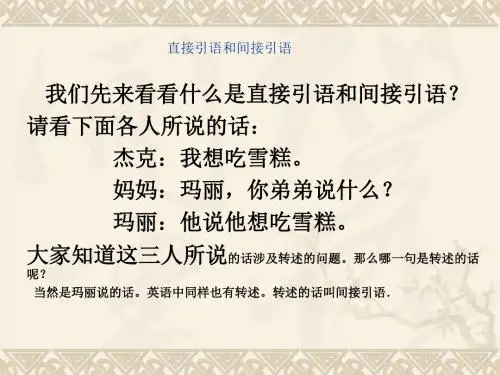
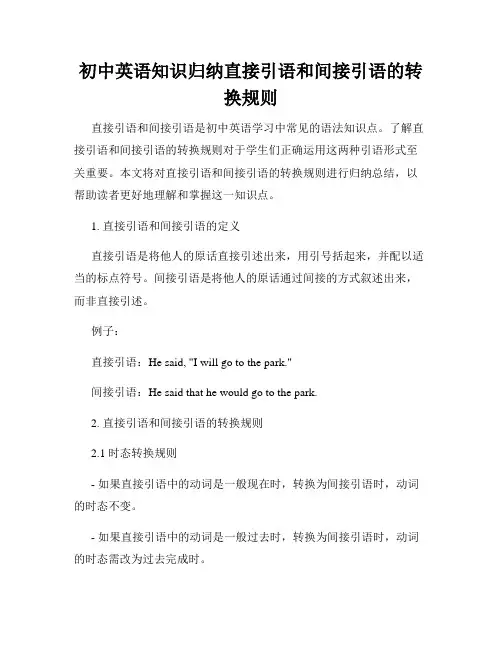
初中英语知识归纳直接引语和间接引语的转换规则直接引语和间接引语是初中英语学习中常见的语法知识点。
了解直接引语和间接引语的转换规则对于学生们正确运用这两种引语形式至关重要。
本文将对直接引语和间接引语的转换规则进行归纳总结,以帮助读者更好地理解和掌握这一知识点。
1. 直接引语和间接引语的定义直接引语是将他人的原话直接引述出来,用引号括起来,并配以适当的标点符号。
间接引语是将他人的原话通过间接的方式叙述出来,而非直接引述。
例子:直接引语:He said, "I will go to the park."间接引语:He said that he would go to the park.2. 直接引语和间接引语的转换规则2.1 时态转换规则- 如果直接引语中的动词是一般现在时,转换为间接引语时,动词的时态不变。
- 如果直接引语中的动词是一般过去时,转换为间接引语时,动词的时态需改为过去完成时。
- 如果直接引语中的动词是现在进行时,转换为间接引语时,动词的时态需改为过去进行时。
- 如果直接引语中的动词是一般将来时,转换为间接引语时,动词的时态需改为过去将来时。
例子:直接引语:She said, "I am reading a book."间接引语:She said that she was reading a book.直接引语:He said, "I was busy yesterday."间接引语:He said that he had been busy the day before.2.2 人称转换规则- 如果直接引语中出现第一人称,转换为间接引语时,需按照受话人的身份进行适当的变化。
- 如果直接引语中出现第二人称,转换为间接引语时,需按照受话人的身份进行适当的变化。
- 如果直接引语中出现第三人称,转换为间接引语时,人称不变。
例子:直接引语:John said, "I am a student."间接引语:John said that he was a student.直接引语:Teacher said, "You should study hard."间接引语:Teacher said that we should study hard.3. 注意事项- 直接引语和间接引语的转换规则适用于陈述句。
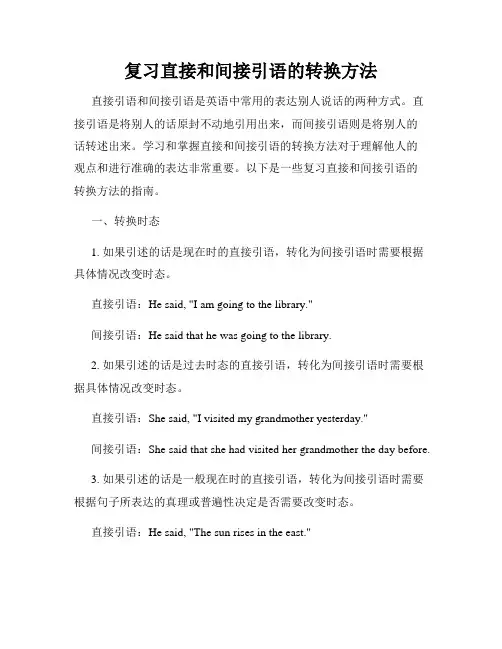
复习直接和间接引语的转换方法直接引语和间接引语是英语中常用的表达别人说话的两种方式。
直接引语是将别人的话原封不动地引用出来,而间接引语则是将别人的话转述出来。
学习和掌握直接和间接引语的转换方法对于理解他人的观点和进行准确的表达非常重要。
以下是一些复习直接和间接引语的转换方法的指南。
一、转换时态1. 如果引述的话是现在时的直接引语,转化为间接引语时需要根据具体情况改变时态。
直接引语:He said, "I am going to the library."间接引语:He said that he was going to the library.2. 如果引述的话是过去时态的直接引语,转化为间接引语时需要根据具体情况改变时态。
直接引语:She said, "I visited my grandmother yesterday."间接引语:She said that she had visited her grandmother the day before.3. 如果引述的话是一般现在时的直接引语,转化为间接引语时需要根据句子所表达的真理或普遍性决定是否需要改变时态。
直接引语:He said, "The sun rises in the east."间接引语:He said that the sun rises in the east.(普遍性事实,不需要改变时态)或者直接引语:He said, "I usually wake up at 7 am."间接引语:He said that he usually woke up at 7 am.(具体情况,需要改变时态)二、转换人称1. 如果直接引语中提到的人称和间接引语所在的句子的主语是同一个人,可以保持第一人称不变。
直接引语:She said, "I am happy."间接引语:She said that she was happy.2. 如果直接引语中提到的人称和间接引语所在的句子的主语不是同一个人,则需要根据具体情况进行相应的改变。
直接间接引语知识点总结引语是写作中不可或缺的一部分,它可以加强观点的可信度,为文章提供支持和证据。
而在使用引语时,需要注意直接引语和间接引语的使用,以确保语言表达准确、流畅。
本文将总结直接间接引语的使用规则和技巧。
一、直接引语直接引语是以原作者的语句直接出现在文章中,使用引号将其括起来。
当我们需要引用别人的观点、观察、评论、对话等内容时,可以使用直接引语。
使用直接引语的注意事项:1. 引用时要忠实于原文,避免误解或改变原意。
可以适当使用省略号[…] 或长破折号(——)来补全完整的内容。
2. 引用部分内容时,需要将其放在引号内,以示区别。
3. 注意标点的使用,引号内部的标点符号应放在引号外,例如:“这个问题真是让我困扰了。
”。
4. 当引用的原文中已经使用了引号时,应使用单引号来区分,例如:“小明对我说:‘我喜欢这个颜色’。
”。
二、间接引语间接引语是将原作者的语句进行转述,并不直接使用原文的语句。
从引用内容中提取核心观点或信息,并使用自己的语言进行再表达。
使用间接引语的注意事项:1. 需要准确传递原文的观点和含义,不可歪曲原意。
2. 改变直接引语的人称、时态、引用部分需要的话语修饰等,以适应文章的语言风格与结构。
3. 需要在引用内容后注明出处,以证明信息的来源。
三、使用直接引语与间接引语的选择在选择使用直接引语或间接引语时,需要根据具体情况进行判断。
以下是一些使用情况的建议:1. 直接引语的使用:- 引用重要且有权威性的观点或评论,以提高文章的可信度。
- 引用他人的真实对话或有特殊含义的话语。
- 引用短小精悍的语句,以便突出重点观点。
2. 间接引语的使用:- 将观点进行归纳总结,以提取核心信息。
- 需要在引语之后进行详细解释,避免篇幅过长。
- 需要在语言风格上与文章整体保持一致。
四、引语的精准运用无论是直接引语还是间接引语,都需要在文章中恰当地运用。
以下是一些建议:1. 引用具有权威性的来源,如专家、学者、经典文献等,以增加论证的力度。
高中英语知识点归纳直接和间接引语的转换高中英语知识点归纳——直接和间接引语的转换引语是英语学习中的一个重要部分,它有两种常见的形式:直接引语和间接引语。
直接引语是直接引用他人的原话,而间接引语则是对他人原话的转述。
在高中英语学习中,我们经常需要掌握直接和间接引语的转换方法。
本文将归纳总结这方面的知识点,并给出相关例子,以帮助读者更好地理解和掌握这一技巧。
一、直接引语的转换为间接引语1. 在转换为间接引语时,需将直接引语中的引号去掉,并用连词that引导从句。
例如:直接引语:Tom said, "I am going to the park."间接引语:Tom said that he was going to the park.2. 当直接引语中包含动词的特定时态时,需根据需要将时态进行转换。
例如:直接引语:She said, "I will come to visit you tomorrow."间接引语:She said that she would come to visit me the next day.3. 直接引语中的人称代词、指示代词和时间状语等也需要根据情况做相应的变化。
例如:直接引语:He said, "I love this book."间接引语:He said that he loved that book.4. 如果直接引语是一般现在时,转换为间接引语时,需根据实际情况使用相应的时态。
例如:直接引语:She says, "I always go to school by bus."间接引语:She says that she always goes to school by bus.二、间接引语的转换为直接引语1. 当我们要将间接引语转换为直接引语时,需将引导从句的连词that去掉,并将动词的时态和人称代词等进行相应的变化。
直接引语和间接引语总结归纳 精品文档
收集于网络,如有侵权请联系管理员删除 直接引语和间接引语
考点1、人称的变化 1)“一随主”。直接引语中的第一人称,一般转换为第三人称,如: He said,“I am very sorry.” →He said that he was very sorry. 2)“二随宾”。直接引语中的第二人称,如果原话是针对转述人说的, 转换为第一人称“You should be more careful next time,” my father told me. →My father told me that I should be more careful the next time. 3)“三不变”。直接引语中第二人称,如果原话是针对第三人称说,转换成第三人称。 如: She said to her son, “she'll check his homework tonight.” →She said to her son that she would check his homework that night. 4)人称的转换包括人称代词、物主代词和名词性物主代词等,如: He asked me, “Will you go to the station with me to meet a friend of mine this afternoon?” →He asked me whether I would go to the station with him to meet a friend of his that afternoon. 考点2、时态的转换 直接引语改为间接引语时,主句中的谓语动词如果是过去时,从句(即间接引语部分)的谓语动词在时态方面要作相应的变化,变成过去时范畴的各种时态(实际也是宾语从句的时态要求),变化如下: 直接引语 → 间接引语 一般现在时→一般过去时 一般过去时→过去完成时 现在进行时→过去进行时 过去完成时→过去完成时 现在完成时→过去完成时 过去进行时→过去进行时 一般将来时→过去将来时 例如: “I am very glad to visit your school”, she said. →She said she was very glad to visit our school. Tom said, “We are listening to the pop music.” →Tom said that they were listening to the pop music. 从句时态无须改变的情况: 1)当主句的谓语动词是一般现在时/将来时的时候,如: He always says, “I am tired out.” →He always says that he is tired out. He will say, “I’ll try my best to help you.” →He will say that he will try his best to help me. 3)当直接引语部分带有具体的过去时间状语时,如: (优化方案 p11 语法专练 2) He said, “I went to college in 1994.” →He told us that he went to college in 1994. 4)直接引语是过去进行时,时态不变。 5)直接引语如果是一般现在时,表示一种反复出现或习惯的动作,时态不不变。 He said, “I get up at sit every morning.”→He said he gets up at sit every morning.” 6)当直接引语中有以when, while,since引导的从句,只改变主句时态,从句时态不变,如: 1. He said,“When I was a child, I usually played football after school.” →He said that when he was a child, he usually played football after school. 2. Mr. Green said to them, “Joe told me all about his story when he asked for a job.” →Mr. Green told them that Joe had told me all about his story when he asked for a job. 6)当直接引语是客观真理或自然现象; 谚语、格言时,如: Our teacher said to us, “Light travels faster than sound.” →Our teacher told us that light travels faster than sound. He said,“Practice makes perfect.” →He said that practice makes perfect. 7)当直接引语中有情态动词should, would, could, had better, would rather, might, must, ought to, used to, need时, 保持不变。例如: The doctor said, “You'd better drink plenty of water.” →The doctor said I'd better drink plenty of water. He said, “She must be a teacher.”→ He said that she must be a teacher. He said, “She ought to have arrived her office by now.”→ He said that she ought to have arrived her office by then. The teacher said, “You needn't hand in your compositions today.” → The teacher said we needn't/didn't need to/didn't have to hand in our compositions. She asked, “Must I take the medicine?” → She asked if she had to take the medicine. 〔注〕:此处用had to代替must更好 考点4:指示代词、时间、地点状语和动词变化 精品文档 收集于网络,如有侵权请联系管理员删除 1)时间状语:
直接引语→ 间接引语 now→ then tomorrow →the next(following)day today→ that day next week →the next(following)week(month, year) yesterday →the day before two days ago→ two days before last week (month, year)→the week(month, year)before this week→ that week(month, year) 2)指示代词:these 变成those 3)地点状语:here变成there 4)动词:come变成go,bring变成take She said, “I won't come here any more.”→She said that she wouldn’t go there any more.. 注意:如果当地转述,here不必改为there, 动词come不必改为go,如果当天转述yesterday, tomorrow, this afternoon等均不必改变。如: She said to us, “I’ll come here tomorrow.”→She told us she would come here tomorrow. 考点5、语序的变化 1)陈述句。用连词that引导,that在口语中常省略。主句的谓语动词可直用接引语中的said, 也可用told来代替,注意,可以说said that, said to sb. that, told sb. that,不可直接说told that, 如: He said, “I have been to the Great Wall.” →He said to us that he had been to the Great Wall. 此外主句中的谓语还常有: repeat, whisper, answer, reply, explain, announce, declare, think等,又如: He said,“I'm late because of the heavy traffic.”(根据句意理解改动词)→He explained to us that he was late because of the heavy traffic. 如果间接引语是由that引导的两个或两个以上的并列从句,第一个连词可以省略,以后的连词一般不省略,以免混乱。 The doctor said, “You are not seriously ill, You will be better soon.”→ The doctor said(that)I was not seriously ill and that I would be better soon. 2)直接引语为一般疑问句,(也称是否疑问句,)间接引语用连词whether或if引导,原主句中谓语动词said要改为asked(me/him/us等),语序是陈述句的语序。 He said, “Do you have any difficulty with pronunciation?” →He asked(me)whether/if I had any difficulty with my pronunciation. 3) 直接引语为选择疑问句,间接引语用whether…or…表达,而不用if…or…,也不用either…or…. 如: He asked, “Do you speak English or French?”→He asked me whether I spoke English or French. 4)直接引语为特殊疑问句,原来的疑问词作为间接引语的连词,主句的谓语动词用ask(sb.)来表达,语序改为陈述句语序。如: He asked,“What's your name?”→ He asked(me)what my name was. He asked us, “How many car factories have been built in your country?” → He asked us how many car factories had been built in our country. 注意1:本身特殊疑问代词做主语语序不变。 My head teacher said:“who likes reading in the park?”→My head teacher asked who liked reading in the park. 注意2: 1. What’ the matter (with you)? 2. What’s wrong (with you)?(语序不变) 3. What’s the trouble (with you)?(语序要变) 5)直接引语为祈使句时,改为间接引语,用带to的不定式表达,谓语动词常是ask, advise, tell, warn, order, request等。如ask sb. to do,(由肯定祈使句变成)ask sb. not to do(由否定祈使句转变),并且在不定式短语中的时间状语、地点状语、人称及时态都作相应的变化。 He said,“Be seated, please.” → He asked us to be seated. “Never come here again!” said the officer nearby. →The officer ordered the villagers never to go there again. “Don't touch anything in the lab without permission,” the teacher said. →The teacher warned the students not to touch anything in the lab without permission.